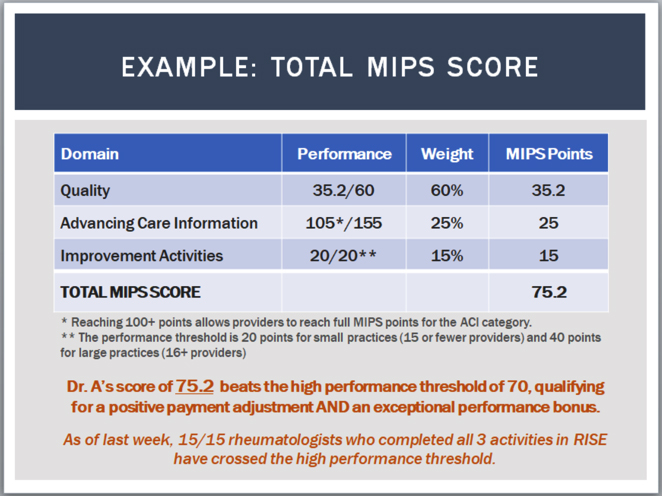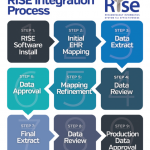The domain with the greatest impact is quality, making up 60% of a provider’s final MIPS score. Under this domain, provider scores are determined by performance on a variety of quality measures. The better providers perform on each quality measure as compared to their peers across the country, the more points they earn. For 2017 reporting, each measure reported, regardless of performance, earns the provider at least three points. Plus, RISE participants can earn up to five bonus points by submitting all the available high-priority and outcome measures in RISE.
Crossing the Threshold
Dr. Yazdany also provided an example of MIPS performance based on aggregate data from RISE participants as of September 2017. Assuming the provider has high performance in the ACI domain with the RISE bonus, fulfills the IA domain as part of a small practice (15 or fewer providers) that participates in RISE and receives monthly reports, and has a mix of low- to medium-high performance on six quality measures and bonus points for submitting extra high priority measures available in RISE, the sample provider earned a total of 75.2 overall MIPS points out of 100 (see Figure 2). Not only does this mean the provider is highly likely to see a positive payment adjustment, it also means the provider crossed the high-performance threshold of 70 total MIPS points and is qualified for an exceptional performance bonus of at least an additional 0.5%. Dr. Yazdany noted that all 15 of the rheumatologists in RISE who had completed all three MIPS domains prior to her presentation had crossed the high-performance threshold. “This is great news, and it suggests that providers [participating in RISE] are going to do very well in this program,” she explained.
The RISE Advantage
The RISE Registry was developed by the ACR to help providers navigate federal reporting requirements and, more generally, to provide a tool that enables quality improvement in rheumatology practices across the country. David Daikh, MD, ACR president, says it’s a tool that the ACR is committed to continually improving and updating. “It’s encouraging to see how much of an advantage the RISE registry provides our members,” he says. “The RISE team is constantly working to ensure we have an easy-to-use solution that can be adapted to changes in reporting requirements and allows rheumatology providers to focus on giving their patients the best care possible.”



